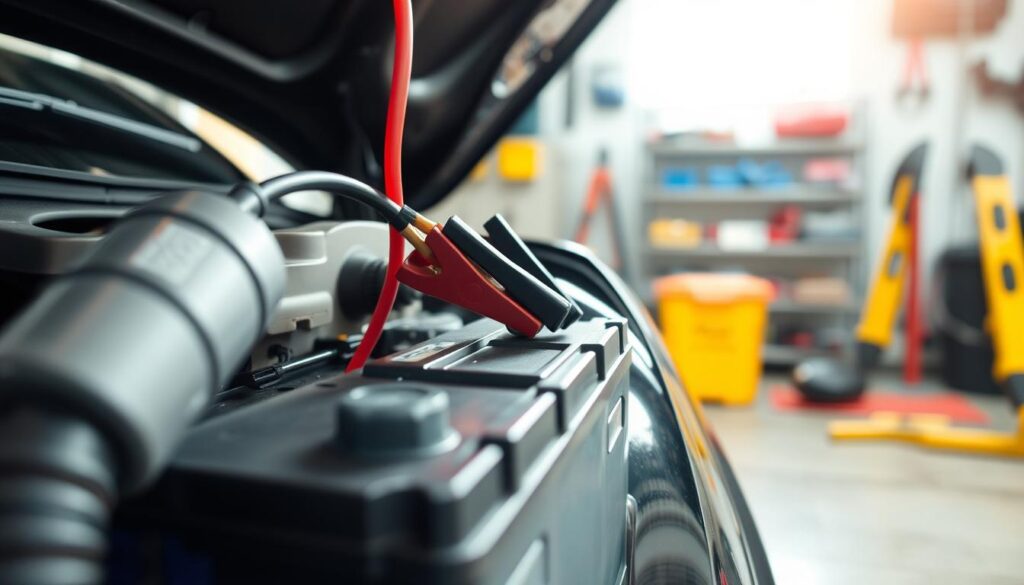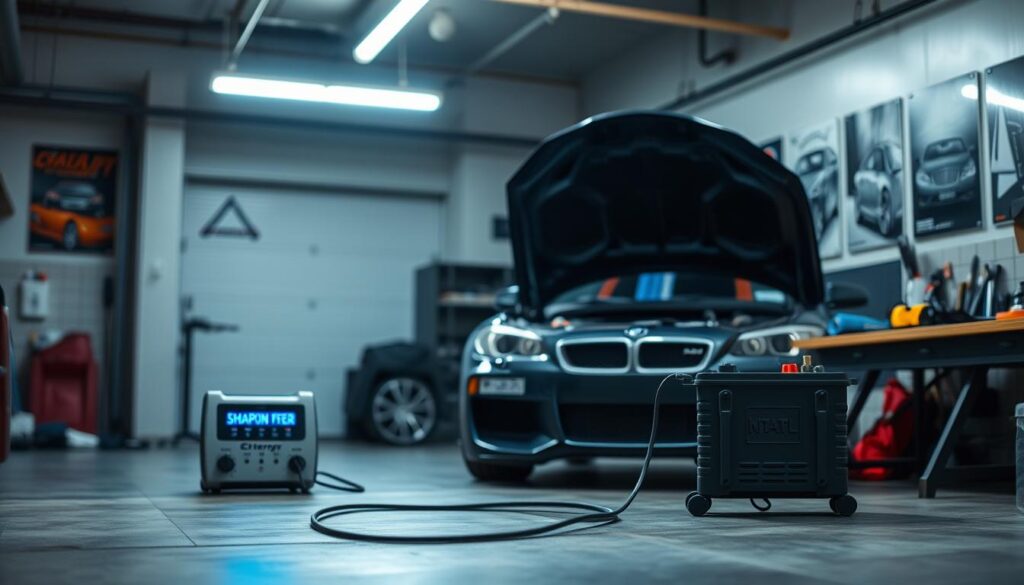Keeping your car battery healthy is key for a smooth ride. Knowing how long to charge it is important. This guide will help you understand how to charge your battery right, keeping it in good shape for longer.
The time to charge a car battery changes based on several things. These include the battery type, how you charge it, and its current state. How long charging car battery can be anywhere from a few hours to days, depending on the situation.
Key Takeaways
- The type of car battery, such as lead-acid or lithium-ion, affects the charging time.
- Factors like battery capacity, charging current, and initial state of charge influence the charging duration.
- Proper charging techniques, such as using a trickle charger or a fast charger, can impact the time required to fully recharge the battery.
- Regularly checking and maintaining your car’s battery can help ensure optimal performance and extend its lifespan.
- Understanding how long to charge car battery before starting is essential for maintaining your vehicle’s reliability.
Understanding Car Battery Charging Basics
Charging your car’s battery is key to keeping it running well. First, it’s important to know about the different types of car batteries. Each type has its own charging needs.
Types of Car Batteries and Their Charging Requirements
There are mainly two types of car batteries: lead-acid and lithium-ion. Lead-acid batteries are more common and need a specific charge to last long. Lithium-ion batteries, found in newer cars, also have their own charging rules.
Factors Affecting Car Battery Charging Time
The time to charge a car battery changes based on several things. These include the battery’s charge level, the charger’s power, and the temperature. The battery’s age and condition also affect how long it takes to charge.
Knowing these factors helps you guess how long it will take to how to charger car battery. This way, you can get your car’s power back faster.
| Factor | Impact on Charging Time |
|---|---|
| Battery Type | Lead-acid batteries take longer to charge than lithium-ion ones. |
| Charger Output | Chargers with higher output charge faster than those with lower output. |
| Temperature | Cold temperatures slow down charging, while warm temperatures speed it up. |
| Battery Condition | Older or damaged batteries charge slower and may not last as long. |
Learning about car battery charging basics helps keep your car’s power up. This ensures your car runs well and reliably.
How Long Charging Car Battery Before Starting?
Charging your car battery right before starting is key. The time needed to charge can change based on a few things. Knowing the best charging time helps your engine start smoothly.
It’s wise to charge your battery for 4 to 6 hours before starting. This lets the battery get enough charge. It fills up the energy needed for your car’s systems and to start the engine.
- For a battery that’s really drained, you might need 8 to 12 hours to fully charge it.
- If your battery is just a bit low, 2 to 4 hours might be enough.
The actual charging time can change for a few reasons:
- The type and size of your car battery
- The charger’s output capacity
- The temperature and the battery’s current charge level
To make sure your battery is ready, follow the manufacturer’s advice. Or, ask a professional mechanic for the best charging time for your car.
“Proper battery charging is essential for reliable engine starting and the overall health of your vehicle’s electrical system.”
Charging your car battery well can save you from the trouble of a dead battery. It makes sure your drive is smooth and easy.
Signs Your Car Battery Needs Recharging
Keeping your car battery healthy is key for your vehicle to run well. If your battery’s power is low, it’s important to know the signs and recharge it quickly. Here are the common signs that mean it’s time to charge your car battery.
Common Indicators of a Drained Battery
These signs can help you know when your car battery needs a recharge:
- Slow Engine Cranking: If your car takes longer to start, it might mean your battery is losing charge.
- Dimming Headlights: If your headlights are dim or flickering, it shows your battery can’t power the electrical system well.
- Battery Warning Light: When the battery warning light on your dashboard comes on, it’s a clear sign your battery needs help.
- Difficulty Starting the Car: If starting your car is hard or it won’t start, it’s a strong sign your battery is drained and needs recharging.
Knowing these signs can help you how to charger car battery or where can i charge my car battery before you get stuck.
“A dead car battery can be a frustrating and inconvenient problem, but being aware of the signs can help you stay one step ahead.”
By noticing the small signs your car’s battery gives, you can how to charger car battery and avoid the trouble of a dead battery. Remember, fixing battery issues quickly can save you time, money, and the stress of being stuck on the road.
Preparing Your Car Battery for Charging
Before you start charging your car battery, it’s important to get it ready. This step-by-step guide helps you charge safely and efficiently. It also helps your battery last longer. Let’s look at the key safety steps to take before charging.
Safety Precautions to Take Before Charging
Charging a car battery needs care and focus. Follow these safety tips to protect yourself and your car:
- Disconnect the battery from the vehicle. Find the negative (-) and positive (+) terminals. Use a wrench to loosen the connections, starting with the negative terminal first.
- Clean the battery terminals. Use a wire brush or a mix of baking soda and water to remove corrosion or buildup.
- Make sure the charging area is well-ventilated. Car batteries can release flammable hydrogen gas during charging. So, it’s important to have good airflow.
- Wear protective gear. Goggles, gloves, and a long-sleeved shirt can protect you from acid spills or battery explosions.
- Avoid smoking or using open flames near the charging area. The hydrogen gas released can be highly volatile and pose a fire hazard.
By following these precautions, you’ll be ready to safely and effectively charge your car battery. Remember, safety is always the most important thing when working with electrical parts in your vehicle.

Using a Standard Battery Charger
Charging your car battery with a standard charger is easy. It can bring back power to your vehicle. Knowing the right steps ensures a safe and efficient charge.
Step-by-Step Guide to Charging with a Traditional Charger
To charge your car battery with a standard charger, just follow these steps:
- Find the battery in your car and disconnect the negative (-) terminal first, then the positive (+) terminal.
- Put the battery in a place with good air flow, away from any flames or sparks.
- Connect the positive (red) clamp to the positive (+) terminal on the battery. Then, connect the negative (black) clamp to a metal ground, like a bolt or the engine block.
- Plug in the charger and turn it on. Make sure the voltage and amperage match your battery type.
- Watch the charging process and let the battery charge for the time recommended. This can be from 4 to 24 hours, depending on the battery and charger.
- When the battery is fully charged, turn off the charger. Then, disconnect the clamps in the reverse order: negative (-) first, then positive (+).
- Put the battery back in your car. Make sure to reconnect the positive (+) terminal first, then the negative (-) terminal.
It’s key to follow the maker’s instructions and be safe when how to charger car battery. Overcharging or not handling it right can be dangerous. Always be careful when how much car battery charger.
“Charging a car battery correctly is crucial for maintaining the health and longevity of your vehicle’s power source.”
Charging with a Trickle Charger or Maintainer
Trickle chargers and battery maintainers are great for how to charger car battery and how much car battery charger costs. They are designed to charge your car battery slowly and safely. This keeps the battery healthy, even when the car is not used.
Trickle chargers give a small, steady current to the battery. This prevents it from getting too full and keeps the voltage just right. They are perfect for cars that sit for long periods, like classic cars or seasonal vehicles. This way, the battery lasts longer and you don’t have to replace it as often.
Battery maintainers watch the battery’s charge and adjust the current as needed. This smart charging stops overcharging, which can damage the battery. They are great for cars parked for a long time. They keep the battery ready to go when you need it.
- Trickle chargers provide a steady, gentle charge to maintain battery health during periods of inactivity.
- Battery maintainers monitor the battery’s charge level and adjust the current to prevent overcharging.
- Both trickle chargers and maintainers can help extend the lifespan of your car battery and reduce the need for frequent replacements.
“Trickle chargers and battery maintainers are essential tools for keeping your car’s battery in top condition, even when the vehicle isn’t being used regularly.”
When using a trickle charger or maintainer, always follow the instructions. Make sure the connections are correct to avoid safety risks. With the right charger, your car’s battery will always be ready to go.

How Long Does a Fully Charged Car Battery Last?
The life of a fully charged car battery depends on several factors. Knowing these factors helps keep your car’s battery working well for longer.
Factors Affecting Car Battery Life Span
Several elements affect how long a car battery lasts. These include:
- Usage patterns – How often and how long you drive, and the electrical load from accessories, matter.
- Climate conditions – Very hot or cold weather speeds up battery aging and shortens its life.
- Battery age and quality – Newer, better batteries last longer than older, lower-quality ones.
- Maintenance and care – Keeping the battery clean and avoiding deep discharges can extend its life.
A well-kept, fully charged car battery can last 2 to 5 years. But, it might need to be replaced sooner if it faces harsh conditions.
| Factor | Impact on Battery Life |
|---|---|
| Usage Patterns | Frequent, high-drain usage can shorten battery life, while moderate use allows for longer lifespan. |
| Climate Conditions | Extreme temperatures, both hot and cold, can accelerate battery degradation. |
| Battery Age and Quality | Newer, higher-quality batteries tend to last longer than older or lower-quality options. |
| Maintenance and Care | Proper care, including regular cleaning and avoiding deep discharge, can extend battery life. |
Knowing what affects a car battery’s life helps you take better care of it. Regular checks and maintenance keep your car running smoothly for years.
Troubleshooting Charging Issues
Common Problems and Solutions
Charging your car battery can sometimes lead to common issues. A battery that won’t hold a charge is a frequent problem. This might be because of a bad battery, loose connections, or a charging system issue. Check the battery terminals, clean off any corrosion, and make sure the connections are secure.
Another issue is a charger that doesn’t work right. If the charger lights don’t turn on or the battery isn’t charging, the charger might be broken. You might need a new charger or to have it fixed. If you’re not sure where to charge your car battery, a local auto parts store or mechanic can help.
Also, watch out for strange noises or smells when charging. These could mean a serious problem like a short circuit or a failing battery. If you notice anything odd, stop charging and get a professional to check the battery for your safety.





